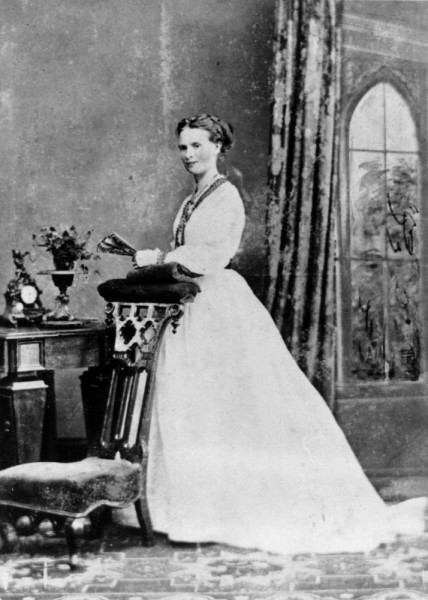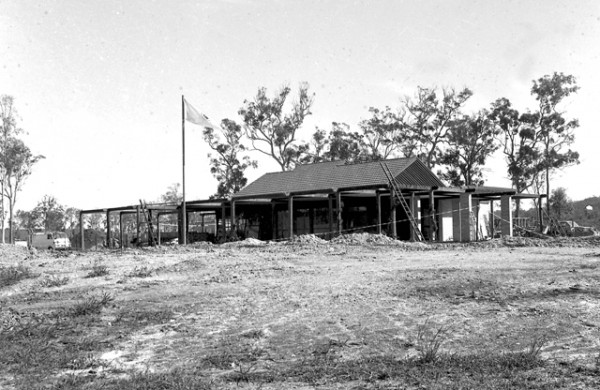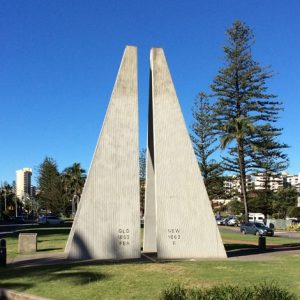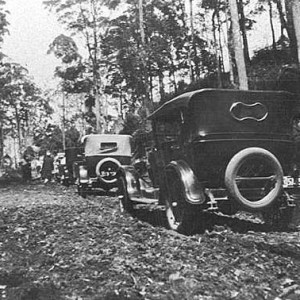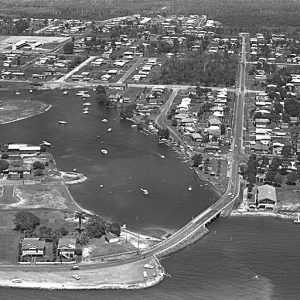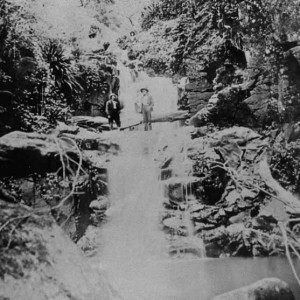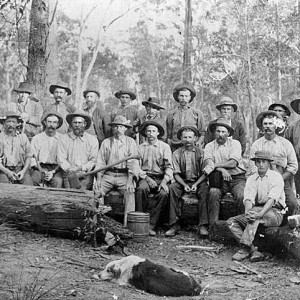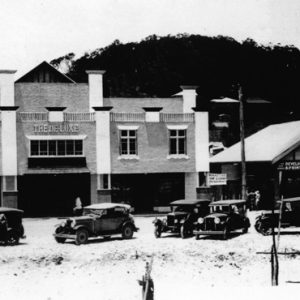
Surveyed by George Pratten in 1847, Helensvale was originally part of the large pastoral run known as Cumboomba (Coombabah), which was leased by William Duckett White on 11 July 1867.
Part of White’s pastoral run was forfeited on 1 January 1870 but he retained over 1,300 acres in the area while the Robinson family held land nearby. In partnership, William Duckett White’s son Ernest and Arthur Robinson started the Helensvale Sugar Plantation. Much of the modern suburb of Helensvale is on land owned by the two families.
There are a number explanations regarding the naming of the plantation. One story is that it was named after Ernest White’s younger sister Helena. An alternative, but not contradictory, story was told by Les Hession whose family had a long association with the property. “Back in the very early days an immigrant came to inspect the land which was dotted with cedar trees and aboriginal artefacts, especially piles of oyster shells by old campfires. The man said to his wife – ‘Helen, lift your veil and look at this beautiful view!’” (The Gold Coast Bulletin, 18 April 1979, page 4)
In the 1870s, Helensvale was described in glowing terms in the Brisbane Courier newspaper “Nothing could be more advantageous than the position of the Helensvale Estate with regard to the river; it comprises nearly a couple of thousand acres of freehold which form a peninsula about half-a-mile of fencing having proved sufficient enough to isolate it; whilst about a ten-mile river frontage is well taken advantage of. Following the banks of the river, 800 acres of fine scrub and forest land is found in unbroken continuity…” (The Brisbane Courier, 2 September 1876, page 7)
By the 1880s the Helensvale Plantation had 55 acres cultivated with sugar with five European and 32 Pacific Islander workers living on the property. In 1892 a Mr Castle was selling implements and machinery from Helensvale and the Logan Witness was declaring an end to sugar cane growing on the Coomera River. In 1895 the property was advertised with the option to buy or lease.
One of the main requirements of successful agricultural land is good transport. By the early 1900s the South Coast Railway line linking South Brisbane to Tweed Heads ran through the region with a railway siding located at Helensvale. Built in 1903, it was used to transport cream and other produce to market. In 1905, Helensvale was advertised for sale as rich grazing and agricultural land. In 1907 the proprietor, Mr H. Dennis, held a clearing sale prior to moving north.
While a number of local families continued to be involved in the sugar cane industry, in the early years of the twentieth century Helensvale became a dairy property owned by William Campbell of Murwillumbah and operated by the Hession family.
In later years, the property was associated with the Siganto family and purchased by Davis Gelatine Pty well known manufacturers of gelatine products. In 1950 the property was again listed for sale (unstocked) at 22,500 pounds. It was purchased by Mr C.T. Bennet, a cane grower from North Queensland for an undisclosed amount.
Little is known of any further change in ownership of the land until the 1970s when it was in the hands of the Mainline Group and major development began to be considered.
The Helensvale Project started when Mainline Constructions and Alliance Holdings formed a company called Oxenford Holdings Pty Ltd. Their aim was to develop 154 hectares at Oxenford and 689 hectares at Helensvale.
The first homes were constructed in 1976 in an area that was part of the original sugar plantation south of Saltwater Creek. By 1978, the project was six months ahead of schedule.
Helensvale was planned for 10,000 people with a district centre servicing Helensvale, Gaven Forest (Pacific Pines) and Oxenford with parklands, shops, amenities and facilities (such as a golf course) part of the development.
Since the commencement of the master planned development in the 1970s, Helensvale has grown into a suburb located near major theme parks, adjacent to a train station and with a wide range of shopping, medical and sporting facilities. It is bounded to the east by Coombabah Lake and Nature Reserve.
Sources of information and further reading
- The Kombumerri Corporation for Culture (ed). The language of the Wangerriburra and neighbouring groups in the Yugambeh region from the works of John Allen and John Lane, The Kombumerri Corporation for Culture, 2001.
- Gray, Phil. A History of Helensvale. Helensvale: Philip R. Gray, 2010.
- The Gold Coast Bulletin, (Southport, Qld.), 21 Feb 1976.
- “The Hessions come back to Helensvale.” Gold Coast Bulletin, (Southport, Qld.), 18 Apr 1979, p. 4.
- “The Lower Coomera.” The Brisbane Courier, (Brisbane, Qld.) 2 Sep 1876, p. 7.
- “Coomera.” South Coast Bulletin, (Southport, Qld.) 20 Jan 1943, p. 3. Web. http://nla.gov.au/nla.news-article188311678
- “For the man on the land.” The Brisbane Courier, (Brisbane, Qld.) 27 Jul 1929, p. 13. Web. http://nla.gov.au/nla.news-article21431564
- Advertisement. The Brisbane Courier, (Brisbane, Qld.) 13 Oct 1905, p. 8. Web. http://nla.gov.au/nla.news-article19414326
- “Stockowners’ meeting.” Tweed Daily, (Tweed Heads, New South Wales), 19 Feb 1917, p. 2. Web. http://nla.gov.au/nla.news-article195838673
- “Helensvale sold.” The Courier-Mail, (Brisbane, Qld.) 2 Mar 1950, p. 7. Web. http://nla.gov.au/nla.news-article49712591
- Clearance sale, Advertising. Queensland Country Life, [Queensland], 9 Mar 1950, p. 20. Web. http://nla.gov.au/nla.news-article97128720
- “Pig Parade.” Queensland Country Life, [Queensland], 17 Jan 1946, p. 5. Web. http://nla.gov.au/nla.news-article97145003
- “Below the range.” The Brisbane Courier, (Brisbane, Qld.), 8 Jul 1907, p. 2. Web. http://nla.gov.au/nla.news-article19378652
- Local and general. (1892, December 24). Logan Witness, p. 2. http://nla.gov.au/nla.news-article163894845
- Display Advertising. (1895, June 8). The Queenslander, p. 1103. http://nla.gov.au/nla.news-article21632740
- Advertising. (1935, April 26). South Coast Bulletin, p. 4. http://nla.gov.au/nla.news-article133478201
- Queensland Government Department of Natural Resources and Mines. www.dnrm.qld.gov.au/qld
